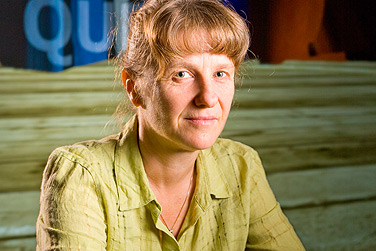Close Up
Digital artist blends literary dexterity with computer technology

Josephine Anstey has been moving away from virtual reality dramas and concentrating instead on performance-based work with the Intermedia Performance Studio. Photo: DOUGLAS LEVERE
-
 Print
Print -
 Comments
Comments
-
“Our goals are to create theatrical performances, but with experimental work that uses technology.”
-
Related element
Take a look at “D-I-Y Diva” and “Workers of the World.”
In “D-I-Y Diva,” flamboyant characters showcase a series of intensely self-absorbed personalities. Narcissists, huge control freaks or histrionic in the extreme, they are “do-it-yourself” divas. Except for one computer-generated character, we see real people interacting with projections of an outsize ego.
“D-I-Y Diva” is part of the far-ranging repertoire of digital artist Josephine Anstey, UB associate professor of media study. Much of Anstey’s work concerns virtual reality fiction applications, in which “the user, as the main protagonist, interacts with virtual characters.”
Recently, however, Anstey has been moving away from virtual reality dramas, concentrating instead on performance-based work with Intermedia Performance Studio (IPS), which she helped establish at UB. Members of IPS include researchers and scientists, along with dramatic performers and other artists. “Our goals are to create theatrical performances, but with experimental work that uses technology,” Anstey says.
Now on sabbatical, Anstey is looking forward to the studio’s March 2009 production of “WoyUbu,” first presented at last summer’s Buffalo Infringement Festival. “WoyUbu” will be fully staged at a Buffalo performance space on Main Street with support from the Robert G. and Carol L. Morris Fund for Artistic Expression and Performing Arts. “The text for ‘WoyUbu’ is taken from two well-known plays,” Anstey explains. “These are Georg Büchner’s ‘Woyzeck’ and Alfred Jarry’s ‘King Ubu.’ Our conception is to mash both plays together and also involve a lot of technology.”
Anstey’s principal collaborators are her husband, Dave Pape, also a member of the media study faculty; Sarah Bay-Cheng, assistant professor of media study; and Stuart Shapiro, professor of computer science and engineering. The group’s interdisciplinary focus unites their individual strengths in virtual reality, 3D graphics and artificial intelligence (AI). “I’ve always been interested in computer-controlled characters and AI agents,” Anstey says. “Those are the kinds of things we evolve into performances.”
A native of southern England who also is a busy mother of a 3-year-old daughter, Anstey says she “always had a tendency to produce things that are quite experimental.” After earning degrees from the University of East Anglia in Britain and UB, she worked as a freelance producer and writer, and then was artist in residence at the Ars Electronica Center in Linz, Austria. Eager to harness the power of the computer to further her work, Anstey went back to school, earning an MFA in electronic visualization from the University of Illinois-Chicago in 2000. Her work is included in the permanent collections of the Museum of Modern Art in New York City and arts centers in Austria, Spain and California.
In “Workers of the World” (2008), Anstey once more blends literary dexterity with digital technology. Robots (assembled from iRobot Creates and laptops running Java, RoombaComm and SNePs) function as a much-maligned and marginalized cleaning staff. Empowered with the necessary technology, however, these robots can speak and also detect the human beings around them. They cannot be ignored, but rather speak a stream of consciousness that echoes 20th-century plays by Peter Weiss, Jean Genet and Bertolt Brecht, all with revolutionary content. “A central theme is how we may think about them as outsiders,” says Anstey.
Currently, Anstey is at work on a piece she calls “The Worry Machine” with a fascinating, yet familiar concept. “The Worry Machine sits on your desktop and worries 24/7 for you,” she says. “It tends to get more paranoid between 3 and 6 a.m., rallies at dawn and gets bleaker during the day.” Anstey hopes to customize this creation, in her words, “to build a generic stream of consciousness which allows a user to enter specific personal content and results in a worry that will feel like their own.”

Reader Comments